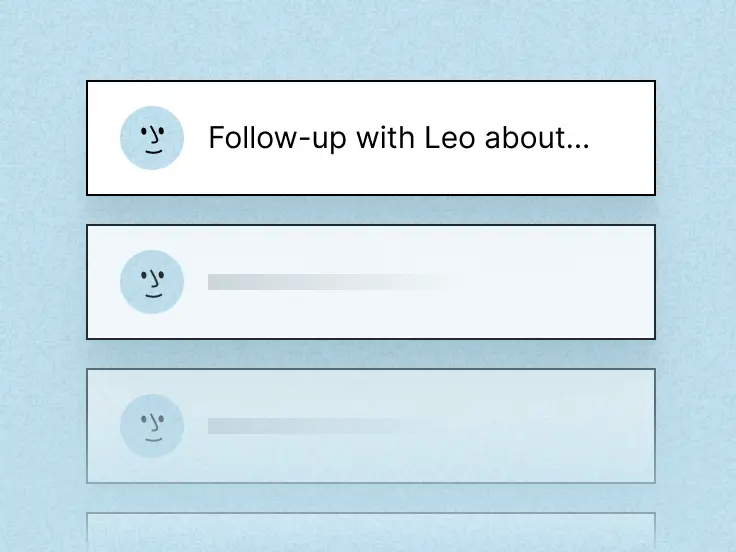Discover folk - the CRM for people-powered businesses
Leads don’t go cold, they get ignored. The gap between first touch and timely follow-up is where most revenue dies. AI Lead Follow Up closes that gap by turning intent signals into fast, relevant replies.
Inside a CRM, AI watches activity across channels, drafts the next message, and schedules it at the right moment. Reps stay focused on conversations while the system keeps each thread alive.
The payoff is simple: more replies, shorter cycles, and cleaner handoffs. This guide defines AI Lead Follow Up, explains why it matters now, shows how it works in practice, and compares the best tools.
What is AI Lead Follow Up?
AI Lead Follow Up is a system that keeps conversations moving after first contact. It reads signals (opens, clicks, replies, meeting no-shows), pulls context from the CRM, and proposes the next step—message, call, reminder—so leads never stall.

It operates across channels. Email, WhatsApp, LinkedIn, and phone notes feed one timeline. The AI drafts a short, relevant follow-up, schedules it at an appropriate time, and routes tasks to the right owner. Sequences pause the moment a human replies.
Core elements, in plain terms:
→ Signal detection: notice meaningful actions and silence windows, not just sends.
→ Context assembly: use CRM fields, past messages, and notes to stay specific.
→ Message drafting: write a concise next step with a single clear ask.
→ Timing & routing: queue at sensible hours, hand off when ownership changes.
→ Guardrails: respect opt-outs, frequency caps, and local compliance rules.
Why Lead Follow Ups Are Important
Main outcomes (plain and practical):
✔️ Higher reply rates: short, relevant nudges land while intent is warm.
✔️ Shorter cycles: clear next steps prevent stalls between touches.
✔️ Better routing: ownership changes trigger handoffs without gaps.
✔️ Cleaner data: every touch logs to the CRM, improving scoring and segments.
✔️ Lower risk: frequency caps and opt-out checks protect sender reputation.
Most deals die in the silent middle. Interest fades fast when the next step isn’t obvious or timely. A consistent follow-up system keeps momentum, reduces no-shows, and rescues leads that would otherwise slip back into research mode.
Revenue compounds when replies arrive sooner. Fast, specific nudges lift meeting acceptance, shorten sales cycles, and surface blockers early. Leaders also get cleaner pipeline signals—fewer “stuck” stages and more reliable forecasts.
How Does AI Lead Follow Up Work?
AI turns raw engagement into the next best action. It watches signals across email, WhatsApp, LinkedIn, calendars, and call notes, then assembles context from the CRM to decide what to send, when, and by whom. Messages stay short, specific, and tied to one clear ask.
The system learns from outcomes. Positive replies, bounces, opt-outs, and no-shows reshape timing and templates. Ownership changes trigger instant handoffs so threads don’t die during PTO or territory swaps.
Simple flow (5 steps):
- Detect: open/click, form fill, meeting booked or missed, quiet window reached.
- Decide: choose “reply now,” “nudge later,” or “escalate” based on intent and stage.
- Draft: generate a one-paragraph email or WhatsApp with a single CTA.
- Schedule & route: send in working hours, assign tasks to the right owner.
- Log & learn: write back to the CRM, update status, retrain on what worked.

💡 folk Tip: Keep follow-ups under 80–120 words with one CTA. Personalize with three anchors only: role, company, and last interaction. Anything longer drops replies and clutters the CRM timeline.
10 Best AI Tools for Lead Follow Ups in 2025
AI keeps follow-ups timely and personal by watching signals and proposing the next step.
Conclusion
AI follow up turns interest into conversations. It watches signals, proposes the next step, and routes it at the right time. Pipelines stay in motion, cycles shorten, and reporting reflects reality.
Start with guardrails in the CRM. Keep messages short with one clear ask. Review outcomes weekly and refine timing, templates, and routing. Add a periodic deep clean to protect deliverability and accuracy.
Choose tools that live close to daily workflows. folk CRM unifies capture, context, and AI follow ups so every lead gets a timely, relevant nudge—without extra ops overhead! ⚡
Frequently Asked Questions
How to automate follow ups for service leads?
Centralize capture in the CRM (forms, inbox, WhatsApp, LinkedIn). Define a clear SLA for first response. Let AI generate short, contextual nudges from past messages and CRM fields, then schedule them in working hours with frequency caps. Route ownership changes instantly so threads never stall, and review outcomes weekly to refine timing and templates.
How to follow up with real estate leads?
Move fast and stay specific. Send a brief confirmation within minutes, reference the exact property or criteria, and propose one concrete next step (call, viewing slot, financing check). Use WhatsApp/SMS for speed and email for details. If no reply, escalate to a short sequence over 14 days and stop after a clear “not interested” signal.
How many times should you follow up with a lead?
Use a simple baseline, then adjust from results. For inbound: 3–5 touches over 7–10 days. For outbound: 5–7 touches over ~14 days across email and one secondary channel. Keep each message under 120 words with one CTA, pause sequences on any human reply, and honor opt-outs immediately.
What is the best AI lead follow-up tool?
For lean, fast-moving teams, folk CRM stands out: clean capture, unified timeline, AI next-best-action, and concise follow-up drafts tied to real context. It keeps threads alive without heavy ops, so leads get timely, relevant nudges by default.
Discover folk CRM
Like the sales assistant your team never had


